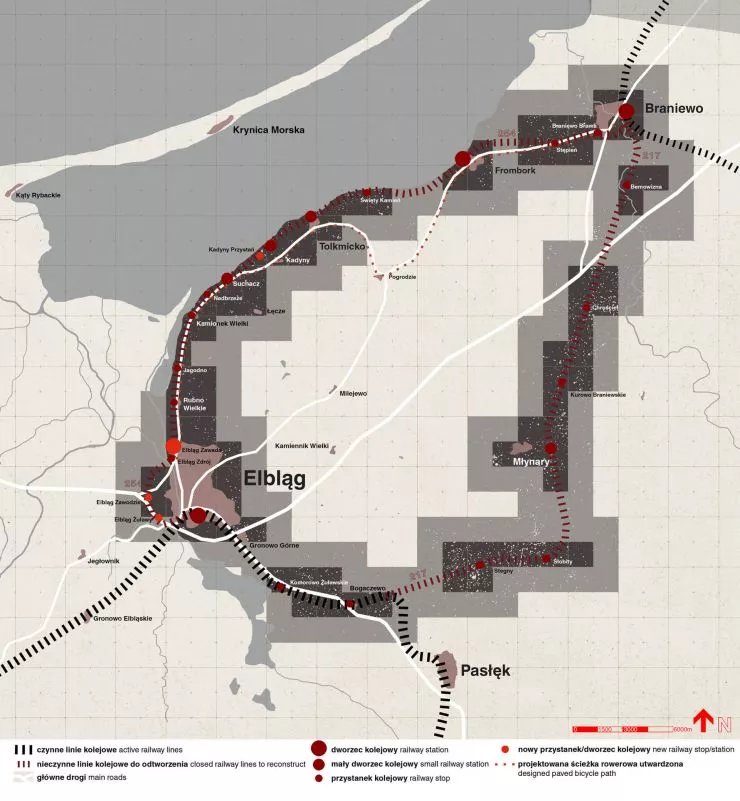The project to restore the Nadzalewe Railway is a response to the search for alternatives to automobile transport. While other European countries are planning to restore closed lines or are attempting to expand existing ones, in Poland more connections are being closed. In the local context, the project would be an answer to the problem of the squandered tourist potential of the lagoon areas, and would also solve the issue of communication between smaller towns in the region and Elblag or Braniew.



orientation
© Radoslaw Bielucy
The project involves connecting the line of the Nadzalewe Railway (No. 254) with the former railroad line No. 204 from Malbork to Braniewo via Elblag, closed in 2004 (its shorter Bogaczewo-Braniewo section with line number 217 was closed in 2013). Both sections have similar lengths (53 and 54 kilometers, respectively), so identical travel times were assumed. The method of running trains as single-track lines was preserved. The trains start from the same station - Elblag Główny - and run in a circle: one clockwise, the other counter-clockwise. They swap each other in the middle of the lap, at stations with additional platforms (Elblag Główny or Braniewo). It would take (with stops at stations) about 50-60 minutes to cover half a lap, assuming a train speed of 80-90 kilometers per hour.



railroad operation diagram
© Radoslav Bielucy
Within each stop and station along the route, bicycle and car parking facilities are planned in the Park&Ride system, and in Elblag and Braniewo there is a connection between the rail system and public transportation. In the case of stops located on the Vistula Lagoon, a return to a rail + ship system is planned, in which the train schedule would be coordinated with the voyages of ships operating from the Vistula Spit.
development, left: Kamionek Wielki; right: Kadyny
© Radosław Bielucy
Three types of passenger stops have been designed along the reactivated route; depending on the needs of the locality, they vary in size:
- Railroad stop - the smallest of the facilities, consisting of a bus shelter with seating and bicycle parking (within the parking area for cars). It was located at the new passenger stops Elbląg Żuławy, Elbląg Zawodzie and Kadyny Przystań, as well as at the existing ones Elbląg Zdrój (previously functioning as a train station), Rubno Wielkie, Jagodno, Kamionek Wielki (solved in detail in theproject), Nadbrzeże, Święty Kamień, Stępień, Braniewo Brama, Komorowo Żuławskie, Bogaczewo, Stegny, Słobity, Kurowo Braniewskie, Chruściel and Bemowizna;
stop
© Radoslaw Bielucy
- A small railroad station - a medium-sized station facility, consisting of an enclosed waiting room, a ticket/information desk, a restroom (adapted for people with disabilities) and a bicycle parking lot (within a parking lot for cars). It was located next to the existing passenger stops Suchacz (the building of the former station is now used for residential purposes), Kadyny (solved in detail in the project), Młynary;
small station
© Radosław Bielucy
- large railroad station - the largest of the facilities, consisting of an enclosed waiting room, ticket office/information desk, bar, toilets (adapted for people with disabilities) and bicycle parking (within the parking lot). It was located at the new Elbląg Zawada stop (solved in detail in the project).



big station
© Radoslaw Bielucy
The most extensive design study has been devoted to a new railroad station in Elblag (Elblag Zawada); here the project envisages the construction of a new large railroad station on an unused area in Mazurska Street and the development of the area behind the railroad tracks on the Elblag River side into a city park, which would be an extension of Larch Park towards the river. Within the project area, several functional zones have been separated, including a nature succession zone, a resident activation zone, a recreation zone, a relaxation zone, a play zone and a sports zone.
Left: development, Elbląg Zawada; right: functional program of the large station
© Radoslaw Bielucy
The developed station infrastructure facilities are single-story buildings based on a module measuring 3×3×4 meters. The structure is supported on 20-centimeter steel columns with glulam infill. Polycarbonate panels and gray corrugated fiber-cement sheets have been adopted on the facades. An extensive green roof has been provided for each building, as well as the installation of photovoltaic batteries on the roofs of the station buildings and the administration and workshop building in Elblag.
The buildings have been designed in such a way that their transport can be carried out by rail on platform cars on special construction carts - type S, used for transporting large-size cargo, with a width of at least 3 meters.
Radoslav BIELUCY
Illustrations: © Author















































